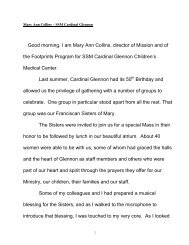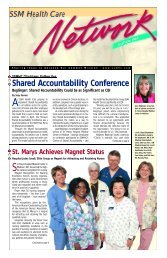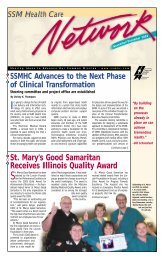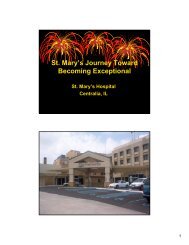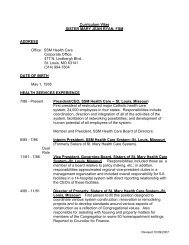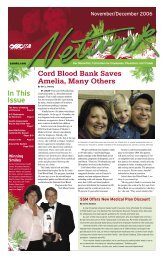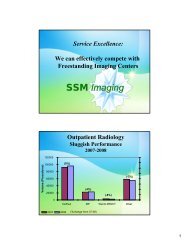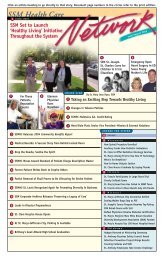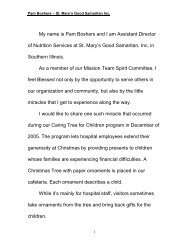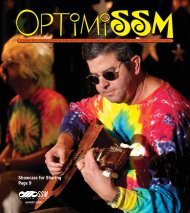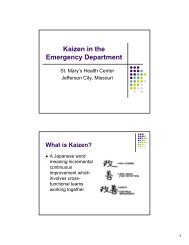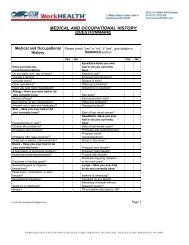Our People - SSM Health Care
Our People - SSM Health Care
Our People - SSM Health Care
You also want an ePaper? Increase the reach of your titles
YUMPU automatically turns print PDFs into web optimized ePapers that Google loves.
A QUARTERLY PUBLICATION BY <strong>SSM</strong> HEALTH CARE FOR EMPLOYEES, PHYSICIANS AND FRIENDS • SPRING 2010<br />
ssmhc.com<br />
<strong>Our</strong> <strong>People</strong><br />
Page 4
<strong>Our</strong> <strong>People</strong>, <strong>Our</strong> Earth<br />
Sr. Mary Jean<br />
“Life isn’t<br />
a dress<br />
rehearsal.<br />
This is it.<br />
You have to<br />
make every<br />
day count.”<br />
Why do you come to work<br />
For many people it’s a paycheck. For some people it’s a purpose.<br />
Beginning on page 4, you can read the stories of “<strong>Our</strong> <strong>People</strong>.” The first ten<br />
<strong>SSM</strong> employees and physicians are featured for their exceptional devotion to<br />
their work.<br />
What do these people have in common<br />
It’s not what they do. They clean floors. They perform surgery on babies<br />
in the womb. They work with geriatric patients. They fix complex medical<br />
equipment. They knit blankets for patients. But no matter what they do,<br />
they inspire others to do their best while demanding the best of themselves.<br />
It’s not how they came to their jobs. One of them said she always wanted<br />
to be a nurse. Another said she only became a nurse because she happened<br />
to go with a friend taking a nursing school entrance test.<br />
What then is the common thread They believe their work is a daily<br />
opportunity to make things better. As one of the featured employees said:<br />
“Life isn’t a dress rehearsal. This is it. You have to make every day count.”<br />
What they do may not even be visible to other people. That doesn’t<br />
matter to them. As one of the Clinical Engineering Service employees in<br />
the “<strong>Our</strong> <strong>People</strong>” section said: “<strong>Our</strong> job is like a series of little victories all<br />
day long.” More stories of exceptional <strong>SSM</strong> people will appear in Optimi<strong>SSM</strong><br />
and on our corporate Web site during the next two years.<br />
The greatest resource we have at <strong>SSM</strong> is our people, but we also feature<br />
a look at <strong>SSM</strong>’s efforts to preserve our natural resources beginning on<br />
page 14. Again, the solution begins with exceptional people devoted to<br />
a purpose. It’s hard work, it requires planning, but most of all it requires<br />
that each of us take individual responsibility for our actions.<br />
May God bless you and inspire you with the realization that what you<br />
do makes a huge difference, both in the lives of people and in the preservation<br />
of the earth.<br />
<strong>SSM</strong> HEALTH CARE is sponsored by the<br />
Franciscan Sisters of Mary<br />
OUR MISSION<br />
Through our exceptional health care<br />
services, we reveal the healing presence<br />
of God.<br />
OUR VALUES<br />
Compassion • Respect • Excellence<br />
Stewardship • Community<br />
CORPORATE OFFICE<br />
477 North Lindbergh Blvd.<br />
St. Louis, MO 63141<br />
Phone: (314) 994-7800<br />
Fax: (314) 994-7900<br />
DIXIE PLATT<br />
Senior Vice President-<br />
Mission & External Relations<br />
SUZY FARREN<br />
Vice President-<br />
Corporate Communications<br />
ALAN WESLEY<br />
Corporate Publications Manager<br />
ANNICE BARNES<br />
Distribution & Editorial Assistant<br />
HOW TO CONTACT US<br />
Send questions or suggestions to<br />
alan_wesley@ssmhc.com<br />
MEDIA INQUIRIES<br />
Reporters seeking additional information<br />
should contact chris_sutton@ssmhc.com<br />
<strong>SSM</strong> <strong>Health</strong> <strong>Care</strong> provides equal employment<br />
opportunities, without regard to<br />
race, color, religion, sex, age, national<br />
origin, sexual orientation, veteran status,<br />
or disability to all qualified applicants<br />
and executives.<br />
Optimi<strong>SSM</strong> is printed on recycled paper<br />
that is recyclable.<br />
WHO WE ARE: Missouri: <strong>SSM</strong> Cardinal Glennon Children’s Medical Center • <strong>SSM</strong> DePaul <strong>Health</strong> Center • <strong>SSM</strong> St. Joseph <strong>Health</strong> Center • <strong>SSM</strong> St. Joseph <strong>Health</strong> Center–Wentzville • <strong>SSM</strong> St. Clare <strong>Health</strong> Center • <strong>SSM</strong><br />
St. Joseph Hospital West • <strong>SSM</strong> St. Mary’s <strong>Health</strong> Center-St. Louis • <strong>SSM</strong> Home <strong>Care</strong> • <strong>SSM</strong> Integrated <strong>Health</strong> Technologies • <strong>SSM</strong> Support Services • St. Francis Hospital & <strong>Health</strong> Services • St. Mary’s <strong>Health</strong><br />
Center-Jefferson City • Illinois: St. Mary’s Good Samaritan, Inc.-Mount Vernon and Centralia campuses • Wisconsin: Boscobel Area <strong>Health</strong> <strong>Care</strong> • Columbus Community Hospital • St. Clare Hospital and <strong>Health</strong> Services<br />
St. Clare Meadows <strong>Care</strong> Center • St. Mary’s Hospital-Madison • St. Mary’s <strong>Care</strong> Center • Stoughton Hospital • Oklahoma: Bone and Joint Hospital at St. Anthony • St. Anthony Hospital • Unity <strong>Health</strong> Center (North<br />
& South)<br />
2
Optimi<strong>SSM</strong><br />
A QUARTERLY PUBLICATION BY <strong>SSM</strong> HEALTH CARE FOR EMPLOYEES, PHYSICIANS AND FRIENDS • SPRING 2010<br />
Welcome to Optimi<strong>SSM</strong>!<br />
For you Sesame Street fans, this edition of<br />
Optimi<strong>SSM</strong> is brought to you by the letter<br />
“G” – Gifts, Green and Great stories.<br />
We have a page of gift shop items from all<br />
<strong>SSM</strong> regions, a spread on some of the green<br />
efforts around <strong>SSM</strong> (with a Kermit the<br />
Frog quote), and a special feature on great<br />
people that we call <strong>Our</strong> <strong>People</strong>.<br />
We also have three other letters to choose<br />
from – E-H-R. This is a look at the electronic<br />
health record from people who work with it.<br />
And if it’s one of those days where you<br />
just want to stand still for a<br />
moment and gaze blankly at<br />
something beautiful, check<br />
out the waterfall on<br />
the back page.<br />
Inside this issue:<br />
<strong>Our</strong> <strong>People</strong><br />
The stories and photos of<br />
4exceptional <strong>SSM</strong> people.<br />
12<br />
Why the Electronic <strong>Health</strong><br />
Record is Better<br />
Six different people. Six different<br />
perspectives on how the<br />
EHR is improving the work<br />
and lives of people.<br />
Green is an Important Color at <strong>SSM</strong><br />
From “green” roofs to “white” roofs. From recycled cardboard<br />
to recycled snow, take a look at what we’re doing to preserve<br />
14the earth.<br />
On the Cover:<br />
Maurine Free, team leader for<br />
the emergency department at<br />
<strong>SSM</strong> St. Clare <strong>Health</strong> Center,<br />
Fenton, Mo. Read Maurine’s<br />
story on page 7.<br />
Super Carol<br />
She swoops in and wields a giant spatula in her cam-<br />
23paign to keep things safe.<br />
Regular Features:<br />
How We’re Doing . . . . . . . 16<br />
Around <strong>SSM</strong> . . . . . . . . . . . 20<br />
3
<strong>Our</strong> <strong>People</strong><br />
<strong>SSM</strong> <strong>Health</strong> <strong>Care</strong> has exceptional people, and they bring something<br />
special to their work – themselves – their upbringing, experiences,<br />
skills, passion and pride.<br />
They are The Twins who take pride in the miles of tiles they keep<br />
clean. The Nice Guy who knows what it’s like to be poor. The Adrenaline<br />
Junkie in the emergency department. The Young Leader. The<br />
Fixers devoted to making things work. The Safety Champion who<br />
gets up in the morning with one purpose in mind. The Accidental<br />
Nurse who discovered her love for Alzheimer’s patients. The Super<br />
Surgeon. The Knitters weaving with love and compassion. The Giver<br />
who never loses a chance to say a kind word.<br />
At www.ssmpeople.com and in future editions of Optimi<strong>SSM</strong>, we’re<br />
featuring these people, and many others, in videos and print over the<br />
next several months. We are proud to call them <strong>Our</strong> <strong>People</strong>.<br />
4
The Twins<br />
Even before birth, the Long brothers did things together.<br />
Kevin and Kelvin Long are identical twins, right down<br />
to their matching glasses. They work together in environmental<br />
services at <strong>SSM</strong> St. Mary’s <strong>Health</strong> Center in Richmond<br />
Heights, Mo., and <strong>SSM</strong> Cardinal Glennon Children’s<br />
Hospital in St. Louis, and about the only way to tell them<br />
apart is that Kevin wears an earring in each ear and Kelvin<br />
wears only one.<br />
They go home together after their six-hour day shift<br />
at St. Mary’s and sleep for six hours before returning for<br />
a 10-hour night shift at Glennon, then back to St. Mary’s.<br />
That’s 64 hours a week for<br />
each spread over four days,<br />
Mon days through Thursdays.<br />
They spend their days<br />
(and nights) looking down<br />
at miles and miles of tile<br />
floors in the two hospitals,<br />
asking themselves if a floor<br />
can be buffed or does it<br />
need to be stripped and<br />
waxed. Each square of tile<br />
is their collective signature. “We do it right, and if we make a<br />
mistake, we come back and fix it,” Kevin said.<br />
Work that would exhaust most people doesn’t seem to faze<br />
them. In fact, they’re thinking about taking on other cleaning<br />
jobs outside the hospitals.<br />
It’s a work ethic that came from their father, a postal worker<br />
who did not talk much about working hard, but instilled the value<br />
in his sons by example. “I don’t think he ever took a day’s vacation,”<br />
Kevin remembers.<br />
And the quality of their work is recognized by co-workers,<br />
supervisors and patients. Pat Key, environmental<br />
supervisor at St. Mary’s, said: “They pay attention to details, and<br />
they are conscientious. I wish I had 10 of them.”<br />
From left: Kelvin and Kevin Long<br />
The Long brothers learned their job by doing it, whether it’s<br />
deftly using their wrists to control a floor buffer that’s powerful<br />
enough to leap out of their hands if they tried to muscle it with<br />
their arms, or elevating the fan drying a freshly waxed floor so air<br />
bubbles aren’t forced into the wet wax. Each element of their work<br />
has been perfected by repetition and paying attention to finer<br />
points like getting the right mix of floor stripper with water.<br />
There are a few hazards. Both have fallen. “That stripper is just<br />
like ice before you dilute it with water,” Kelvin said, laughing.<br />
They’ve become accustomed to the eye-watering fumes from<br />
their cleaning solutions, though they are aware others aren’t immune<br />
to the odor’s effect and ask patients if they would be<br />
bothered by the smell before they begin their work.<br />
And when their work is finished, it sometimes follows them<br />
home. They dream of working on floors in their sleep.<br />
The Knitters<br />
We care about you. We’re praying for you.<br />
We’ll see you through this. This is what the<br />
staff of the internal medicine department at<br />
<strong>SSM</strong> St. Joseph Medical Park in St. Charles,<br />
Mo., want their patients to know.<br />
In 2009, the department began a prayer<br />
shawl ministry, combining compassion<br />
and their love of knitting to reach out to<br />
patients having a particularly difficult<br />
time. Two employees create the blanket at<br />
home, offering individual prayers while they knit. Then the<br />
other employees and physicians use their lunchtime and breaks<br />
to affix tassels and offer their own prayers<br />
and blessings. Since beginning their ministry,<br />
the department has created and distributed<br />
27 shawls, with several currently in progress.<br />
While the staff is happy to share their<br />
ministry, they wish only to be identified as<br />
a department, not individually. One knitter<br />
said simply, “Some of our patients only<br />
identify the shawl with the person who<br />
presented it to them. They know that there<br />
are a lot of people behind its creation, but<br />
they don't know who they are. And that's<br />
OK. All they have to know is that someone cared."<br />
Go to www.ssmpeople.com to watch <strong>Our</strong> <strong>People</strong>.<br />
5
The Nice Guy<br />
It started with cows.<br />
At age 12, Carl Dodd began spending his<br />
summers living and working on farms near his<br />
hometown of Monticello, Wis. The cash he and<br />
his two brothers earned on the farms paid for<br />
their clothes and school supplies and provided<br />
spending money for the year. So Carl rose at 5<br />
a.m. daily, milked the cows, baled hay, drove a<br />
combine through the oat fields, planted, performed<br />
other chores and finished about 7 p.m.<br />
by milking the cows again.<br />
His education continued behind a bar.<br />
Dodd’s parents owned a bar and restaurant in Carl Dodd<br />
Monticello (population 800) but with eight bars<br />
in the community, competition was fierce and money scarce. “The<br />
hours were 8 a.m. until midnight, seven days a week,” he said. “In<br />
the 20 years my parents owned it, they must have aged 60 years.<br />
We were dirt poor.”<br />
At 16, he began cooking and tending bar in his parents’ business,<br />
listening to the triumphs and troubles of friends and neighbors<br />
sitting on the barstools. “You knew everybody and you heard everything<br />
about them,” Dodd said.<br />
By age 19, Dodd was in Viet Nam (1970-71) patrolling the<br />
Mekong Delta in a boat. Slowly motoring at night through canals<br />
that were barely 20 feet wide and thickly lined with vegetation,<br />
he came under fire 47 times during his tour of duty. He said, with<br />
a hint of humor, “Hopefully, it made me a better person.”<br />
After returning from Viet Nam, he moved to Madison, worked<br />
three years as a private detective, and then became a bill collector.<br />
The Giver<br />
“Never lose a chance to say a<br />
kind word.”<br />
One doesn’t have to spend<br />
much time with Amy Merten<br />
to realize that this phrase inscribed<br />
on her office wall is<br />
more than a decoration. It is<br />
clear that, for the cardiology<br />
supervisor at the Centralia,<br />
Ill., campus of St. Mary’s<br />
Good Samaritan Inc., kindness<br />
is a way of life. Merten’s Amy Merten<br />
colleagues know her as a<br />
happy, easy presence – quick to give a smile or lend a hand.<br />
When she walks through the halls of her department or the<br />
hospital, she cheerfully greets everyone she meets and shares<br />
laughs and hugs with patients who are regular visitors to cardiac<br />
rehabilitation.<br />
“I didn’t look forward to my day,” Dodd said.<br />
“We tried to collect money from people and,<br />
if we couldn’t do that, we sued them.”<br />
Dodd then joined St. Mary’s as a patient account<br />
collector, with the word “collector” later<br />
changed to “advisor” because there was a<br />
marked difference between the way St. Mary’s<br />
handled billing and the way Dodd’s previous<br />
agency did. “We spend more time providing financial<br />
assistance to patients than we do collecting,”<br />
he said.<br />
Dodd listens to patients and determines<br />
their financial status. Many of the patients are<br />
embarrassed, angry, and frightened, holding a<br />
medical bill they cannot pay with the added<br />
strain of their own ailment or the illness of a<br />
loved one. They are a short step away from losing everything and<br />
bracing for more threats, when they hear Dodd say “let’s see what<br />
we can work out.” In most cases, the bill is written off when Dodd<br />
discovers their income level is too low. St. Mary’s wrote off $14<br />
million in bills in 2009 and set up payment plans for other patients.<br />
Relief often dissolves into tears.<br />
“Financial assistance is the best part of my job,” Dodd said.<br />
“We’re doing people a service, and we have so many ways to help<br />
them. I look forward to coming to work.”<br />
Dodd has found himself in a job, where his experiences with<br />
poverty, hard work, listening to people, understanding fear, and<br />
what it’s like to have few options, have come together in the<br />
most important word he associates with his job: “compassion.”<br />
“You have to put yourself in the shoes of other people who<br />
are doing the best they can,” he said.<br />
What’s her secret<br />
“I enjoy what I do,” Merten says. “For as long as I can remember,<br />
I’ve wanted to be a nurse. I’ve always known that I want to help<br />
people. There’s not a day that I get up in the morning that I don’t<br />
want to come to work.”<br />
For 24 years she’s felt this way. Merten began her career at<br />
St. Mary’s Good Samaritan in 1986 on the surgical unit. She<br />
quickly moved to the intensive care unit where she worked for<br />
12 years. The last dozen years have been dedicated to cardiology.<br />
In each of her roles at St. Mary’s Good Samaritan, Merten has<br />
been defined by her desire to help others, both her patients and<br />
her coworkers. She considers her six years of service on the<br />
hospital’s mission team to be some of her most rewarding work,<br />
especially her membership on the subcommittee for the Spirit<br />
Fund. This fund distributes thousands of employee-contributed<br />
dollars each year to colleagues who are facing personal crises.<br />
“I was brought up in a very loving, Christian home. I was<br />
taught to treat people as I want to be treated,” Merten said.<br />
“I’ve been blessed in many ways in my life and I try to extend<br />
the same grace and blessings to others.”<br />
6
The Young Leader<br />
Maurine Free is her own toughest critic. Since last May, she’s<br />
been the team leader for the emergency department at the new<br />
<strong>SSM</strong> St. Clare <strong>Health</strong> Center in Fenton, Mo., where she supervises<br />
more than 50 people. Managing is a new challenge for the<br />
31-year-old nurse.<br />
Free didn’t expect to become a nurse at all, let alone manage<br />
an ED. In school, she found math and science hard and figured a<br />
nursing career was out of the question. But people encouraged<br />
her to be a nurse; they saw something in her. And now she realizes:<br />
“There’s so much more to being a nurse than science.” Like compassion.<br />
Like service.<br />
First she worked at a children’s residence and later at a nursing<br />
home, both of which she loved, but she needed something more. So<br />
she moved to the ED in a large trauma center and found her niche.<br />
“The ED changes all the time,” she said. “Every day is different.”<br />
She was a per diem nurse at St. Clare when Martha Rahm,<br />
ED director, approached her about becoming manager.<br />
Free was hesitant at first. But she went through the requisite<br />
interviews and got the job. Rahm described what she wanted: “Your<br />
job,” she told Free, “is to take care of the people who take care of<br />
the people.” Free was up for it. She started as manager in May 2009.<br />
The first six months were really hard. Not only was St. Clare<br />
a brand new hospital, 50 new employees had been hired in the<br />
ED since March 31. <strong>People</strong> didn’t know one another or where to<br />
find things. Processes were new. It was up to Free to make the department<br />
gel; she found she couldn’t do it overnight.<br />
James Reedy, a friend and director of nursing, Neurosciences<br />
Institute at St. Clare, put things into perspective. “You used to be<br />
an expert,” he told Free. ”You were the best bedside nurse. This<br />
is something new, and you expected to be great at it right away.<br />
Give yourself some time!”<br />
She took his advice, along with that of Rahm, who said running<br />
a department is “like figure skating. It looks easy, but it’s not.”<br />
In early 2010, the department began to gel. Free spends a lot<br />
of time walking around, rounding on patients and her staff, and,<br />
when things get busy, stepping in to support the bedside nurses. She<br />
would never ask anyone to do something she wouldn’t do herself.<br />
One big focus for Free is raising staff awareness that they are<br />
constantly onstage. “Patients listen to everything that’s going on,”<br />
she said. “They’re watching us, and they’re listening to what we<br />
say. The only time we’re offstage is in the break room.”<br />
She demands of herself that she give 100 percent — 100 percent<br />
of the time. “I went into nursing to make a difference,” said Free,<br />
who works hard to meet the needs of her staff.<br />
“I’m an optimist,” she said. “<strong>People</strong> who enjoy their work take<br />
better care of patients.”<br />
Maurine Free<br />
Go to www.ssmpeople.com to watch <strong>Our</strong> <strong>People</strong>.<br />
7
The Adrenaline Junkie<br />
“ER people are adrenaline junkies. What’s<br />
going on now won’t be going on 30 minutes<br />
from now. I thrive on organizing chaos.”<br />
Kris Mims has been an emergency room<br />
nurse for 40 years. And Mims can’t imagine<br />
being anywhere else, although the years may<br />
have tempered her a little.<br />
“You start out thinking you’re going to save the world, and<br />
then you realize that all you can do is the best you can,” she said.<br />
“You can’t change the world, but you can make things better.”<br />
Mims is director of the Emergency Department at<br />
<strong>SSM</strong> St. Joseph <strong>Health</strong> Center, St. Charles, Mo. She’s also been<br />
at DePaul, St. Mary’s (St. Louis), and a host of other EDs in St.<br />
Louis and elsewhere.<br />
She likens her ED memories to a scrapbook filled with pictures<br />
of people she can see just as clearly as if they were standing in front<br />
of her. She remembers a lot of the sad things. The worst: Child abuse.<br />
But there was the time the trucker drove himself to the ED<br />
with severe chest pain.<br />
He coded, received great care and a month later, showed up in<br />
the ED to say thank you to the staff for saving his life. She tears<br />
up at the memory.<br />
Mims’ mother, who was a nurse, inspired her to become one.<br />
“I grew up listening to her stories,” she recalled. As a young<br />
nurse, Mims wanted to go to Viet Nam. Instead, she met<br />
her husband, and her life took a different course. They<br />
have two children, one of whom is also a nurse.<br />
Mims started as a staff nurse, and early on asked herself<br />
if nursing was a job or a career. When she answered that<br />
question, she went back to school first for her bachelor’s<br />
and later for her master’s. The fact that she’s done it all<br />
serves her well in this role. She is able to juggle volume<br />
and knows to involve her staff in decisions that affect them.<br />
All these years in the ED have given her a certain outlook on<br />
life. “Life isn’t a dress rehearsal,” she said. “This is it. You have to<br />
make every day count. In the ED, you learn that quickly. I’ve seen<br />
people who kissed their loved one good bye and never saw them<br />
again. <strong>People</strong> take life for granted.”<br />
Her wisdom extends to the smallest things. Take the time a<br />
homeless man arrived in the ED with a cast that had been on for<br />
way too long. Once removed, the cast contained all sorts of “crawly<br />
things.” And the smell was bad. Mims suggested a simple solution:<br />
“Keep a jar of Vicks around and put a dab of it under your nose.”<br />
This year the St. Joe ED is expanding, which is good news,<br />
though juggling the space during the interim will be another<br />
challenge. But Mims is up for it.<br />
“I can’t imagine myself anywhere else.”<br />
Kris Mims<br />
8
The Fixers<br />
Throughout <strong>SSM</strong> <strong>Health</strong> <strong>Care</strong> are 65,000 medical devices<br />
— from relatively simple suction units to sophisticated,<br />
radiation-delivering linear accelerators.<br />
There are MRIs, ECGs and CT scanners; colonoscopes,<br />
bronchoscopes and endoscopes; and infusion<br />
pumps, infant warmers and intravenous poles. Just about<br />
everything a patient does at <strong>SSM</strong> hospitals from Wisconsin<br />
to Oklahoma is tied to a medical device in some way. So who<br />
keeps all these devices running, purring, humming, beeping,<br />
blinking, clicking, flashing<br />
About 110 employees of <strong>SSM</strong>’s Clinical Engineering Service<br />
(CES), that’s who. CES, a department of <strong>SSM</strong> Integrated <strong>Health</strong><br />
Technologies, maintains the devices that monitor, diagnose and<br />
treat patients.<br />
Thurmond Waits, BMET II, St. Mary’s <strong>Health</strong> Center, Richmond Heights, Mo.<br />
Ever wonder what happened to some of those intellectually<br />
curious kids who dissected their families’ VCRs and radios to see<br />
what made them tick, whose hobbies were tinkering with cars<br />
and building robots Some of them work for CES today.<br />
They fix things.<br />
“We like what we do. We love what we do,” said Russ Storck,<br />
who restores old tractors away from his job as CES operations<br />
manager at <strong>SSM</strong> St. Mary’s <strong>Health</strong> Center in Richmond Heights,<br />
Mo. “That’s why I’ve been here for 32 years.”<br />
“<strong>Our</strong> job is like a series of little victories all day long,” said<br />
Jerry DeGeare, BMET II at St. Mary’s. (BMET stands for biomedical<br />
electronics technician). “Some days the problems are<br />
much larger than other days. But basically that’s what we do.<br />
We solve problems.”<br />
CES employees are on call 24-7. Though upkeep of the more<br />
sophisticated equipment, say the da Vinci surgical system, is covered<br />
by service contracts, the vast majority of devices are serviced<br />
by CES.<br />
“By doing this, we’re saving thousands of dollars,” said Frank<br />
Bodenschatz, BMET III, <strong>SSM</strong> St. Clare <strong>Health</strong> Center, Fenton, Mo.<br />
System-wide, the savings add up.<br />
Ron Sanders, CES operations manager,<br />
<strong>SSM</strong> St. Clare <strong>Health</strong> Center, Fenton, Mo.<br />
“We can maintain it<br />
cheaper, faster and better<br />
because we’re on-site,”<br />
said Heidi Horn, vice president<br />
- CES, who noted<br />
that the department saved<br />
more than $1.3 million in<br />
contract costs between<br />
2007 and 2009.<br />
"CES' technicians are<br />
very smart and they take a<br />
lot of pride in their work<br />
and the value they provide,” Horn added.<br />
To keep the devices running, CES employees stay abreast of<br />
the latest technology by undertaking regular training, said Ron<br />
Sanders, CES operations manager at St. Clare.<br />
Once upon a time, the technology wasn’t so high tech, added<br />
Sanders who has worked in hospitals for 43 years. There were<br />
on-off, high-low buttons.<br />
“It was simpler. It was easier,” Sanders said. “But the technology<br />
has made things a lot better for the patient.”<br />
Many <strong>SSM</strong> caregivers are familiar with CES’ handiwork and<br />
know the department’s members by name — their customer satisfaction<br />
ratings are high.<br />
But the department’s deeds aren’t always evident to patients<br />
who may not give much thought to who’s maintaining their<br />
blood pressure cuffs. Often the only signs they’ve been on the<br />
scene are the yellow, initial-bearing labels they affix to devices<br />
they performed routine maintenance on.<br />
Keeping the equipment running for the sake and safety of patients<br />
is always their No. 1 priority, said Joyce Perkins, BMET III<br />
- lead tech at St. Mary’s.<br />
“I want to do quality work and I want to make sure our patients<br />
get the best care they can,” Perkins said.<br />
Jerry DeGeare,BMET II at <strong>SSM</strong> St. Mary’s <strong>Health</strong> Center, Richmond Heights, Mo.<br />
Go to www.ssmpeople.com to watch <strong>Our</strong> <strong>People</strong>.<br />
9
The Super Surgeon<br />
Dr. Ed Yang says children are angels in disguise, and<br />
when they get better, it’s a joy to watch.<br />
Yang is a pediatric surgeon and co-director of<br />
the St. Louis Fetal <strong>Care</strong> Institute at <strong>SSM</strong> Cardinal<br />
Glennon Children’s Medical Center in St. Louis. He<br />
came to Glennon in March 2009 from Vanderbilt<br />
Children's Hospital in Nashville, Tenn.<br />
As a pediatric surgeon, Yang uses his expertise to<br />
take care of children who require surgery from birth<br />
to about 18 years old. At times, he even diagnoses<br />
and treats fetal anomalies — while the baby is still<br />
inside the womb.<br />
But some of the most important — and rewarding work —<br />
happens before he even sets foot in an operating room.<br />
“One of the most inspiring things to me is helping families —<br />
especially the mothers — get through the very tough time where<br />
they are getting the news that their baby is going to be sick,” Yang<br />
said. “These parents are incredibly courageous and strong and it is<br />
a privilege to be part of helping them get through this tough time.”<br />
Yang said one of the most remarkable days of his professional<br />
career actually happened only recently. He performed surgery on<br />
a baby in the womb that had a hole it its diaphragm and very small<br />
lungs. The lungs were small because of a condition called Congenital<br />
Diaphragmatic Hernia. Later that same day, he performed the exact<br />
Charlie Taylor and mother Molly Mueller<br />
were the first surgical patients of the<br />
St. Louis Fetal <strong>Care</strong> Institute. Dr. Yang<br />
removed an amniotic band wrapped<br />
around Charlie's right leg in the womb<br />
at 24 weeks.<br />
same procedure on a baby<br />
that was outside the womb.<br />
It was only at the end of a<br />
very exhausting day that Yang<br />
realized what he had done. “I<br />
performed surgery before birth<br />
for this disease and then after<br />
birth for the same disease,”<br />
he said. “So I thought, ‘Who<br />
gets to do that’ What an<br />
amazing privilege to be able<br />
to help these two children.”<br />
For Yang, it’s all about<br />
helping children.<br />
“I remember one child that<br />
I was treating for chest problems.<br />
He was so sad and just<br />
hurting. It was very heartbreaking<br />
to come into the room<br />
and see him so depressed. But<br />
as he got better, his face just began to light up. It’s that kind of<br />
experience that inspired me to want to work with kids.<br />
“I wouldn’t say this too loud, but I would often do this work<br />
for free,” he said. “Seeing the children happy and smiling…that’s<br />
priceless. It’s a joy to do this work.”<br />
S’ala Davis and her mother Janice Evans talk to Dr. Yang just before surgery on Jan. 22, 2010. S’ala’s baby Ali was the first baby ever born at Cardinal Glennon.<br />
10
The Safety Champion<br />
Growing up, Debbye Luetkemeyer was encouraged by her parents<br />
to take pride in whatever job she took on, to finish what she started<br />
and to do her very best at everything. And they’d ask her, at the<br />
end of the day, a simple question.<br />
“It’s a question I ask my children every day,” said the mother<br />
of four, ages six through 29. “‘Did you do your personal best’<br />
whenever they’re turning something in.”<br />
Luetkemeyer still lives that work ethic. But her best these days<br />
revolves around doing what’s best, safest for patients and employees<br />
of <strong>SSM</strong> <strong>Health</strong> <strong>Care</strong>. When <strong>SSM</strong>HC – St. Louis reorganized<br />
in 2008, Luetkemeyer’s responsibilities expanded, along with a job<br />
title that could clutter any business card: Corporate Responsibility<br />
Program Contact and Regulatory Coordinator, South Operating<br />
Group, <strong>SSM</strong> <strong>Health</strong> <strong>Care</strong> – St. Louis.<br />
“I am filling in many gaps you might say,” she said, laughing.<br />
Luetkemeyer typically arrives at her desk at 6:30 a.m. with a<br />
singular purpose: making sure patients are safe when they come<br />
to <strong>SSM</strong> hospitals for care. She works with hospitals to ensure<br />
they are complying with state and federal regulations and Joint<br />
Commission standards for patient safety. But, at <strong>SSM</strong>, the standard<br />
is even higher, she said:<br />
“Exceptional health care.”<br />
At <strong>SSM</strong>, safety is one of the<br />
fundamental ways we measure<br />
exceptional patient care. To help<br />
achieve that goal, Luetkemeyer<br />
can be found on some days listening<br />
to patients talk about<br />
how their hospital visits might<br />
have been better. Other days,<br />
she collaborates with caregivers<br />
on how to make sure nothing<br />
happens to patients outside<br />
their normal courses of care.<br />
Doing her best to help keep<br />
patients safe excites Luetkemeyer.<br />
“It’s why I get up every<br />
morning and come to work,”<br />
she said. “I don’t do any of<br />
this by myself. I’m one of<br />
many. We all work together<br />
to make it happen.”<br />
Debbye Luetkemeyer<br />
The “Accidental” Nurse<br />
Nursing has been Debbie Coy’s passion for 14 years. But Coy<br />
didn’t enter the profession like most people.<br />
“I really only became a nurse because I happened to go with my<br />
friend to take the nursing school entrance test,” said Coy, a licensed<br />
practical nurse at St. Anthony South in Oklahoma City. “She<br />
Debbie Coy<br />
didn’t want to go alone, so I went with her, took the test and I<br />
was accepted.”<br />
The rest, as they say, is history.<br />
Even before that fateful day, Coy was no stranger to health<br />
care. At age 17, she began working in a hospital as a tech. She<br />
later moved on to work at a nursing home and that’s where she<br />
found her true calling.<br />
“I love geriatrics, especially Alzheimer’s patients,”<br />
Coy said. “<strong>People</strong> tell me I have the<br />
‘Alzheimer’s aura’, because I can really relate to<br />
those patients — especially the ones that have a little<br />
spunk to them.<br />
“Many of my patients are in their 70s, 80s or<br />
older and may not have much time left, so I want<br />
to make sure their last days are going to be happy<br />
ones,” she said. “Going that extra little step is so<br />
important. Taking care of them while they are here<br />
makes me feel good.”<br />
Coy said it is sometimes sad to see her patients’<br />
conditions worsen due to their Alzheimer’s. She<br />
takes care of each one as if they were a friend. “I<br />
can spend hours with an Alzheimer’s patient, just<br />
talking with them or walking around with them,”<br />
she said.<br />
So what is her secret to working with her patients<br />
Ice cream.<br />
“When my patients get a little irritated or<br />
confused, a bowl of ice cream goes a long way,”<br />
she said.<br />
Go to www.ssmpeople.com to watch <strong>Our</strong> <strong>People</strong>.<br />
11
Why the Electronic <strong>Health</strong><br />
Admitting<br />
Before EHR, the patient registration and admitting staff at St. Mary’s Hospital<br />
in Madison, Wis., used a printed schedule or made multiple phone calls to find<br />
out why a patient was there and where they needed to go.<br />
With the EHR, that information is already in the system, saving three to<br />
four minutes per patient, according to Marian Bemis, patient registration application<br />
specialist.<br />
EHR allows all <strong>SSM</strong><br />
hospitals in Wisconsin as<br />
well as many clinics to instantly<br />
share information.<br />
“Patients appreciate that<br />
they aren’t asked the same<br />
questions each time they<br />
come to the hospital,”<br />
Bemis said.<br />
Marian Bemis, (standing) patient<br />
registration application specialist,<br />
with emergency services nurse<br />
Kelly Murray. Bemis says that<br />
patients are admitted three to<br />
four minutes faster with the EHR.<br />
Physicians<br />
Pharmacists<br />
According to pharmacist Dave Billing, director of<br />
pharmacy, <strong>SSM</strong> DePaul <strong>Health</strong> Center, Bridgeton, Mo.,<br />
the EHR helps pharmacists in the following ways:<br />
• Drug orders and physician progress notes are<br />
always legible.<br />
• Computer access to medical charts has cut<br />
down on the walking time of pharmacists hunting<br />
for a paper medical record.<br />
• Access to records at multiple computers also<br />
means more than one person at a time can see<br />
the information.<br />
• The patient’s medical history, allergies and<br />
other prescription medi cations are all listed.<br />
• The pharmacist can spend more time talking<br />
with physicians about the patient’s care and<br />
less time searching for information.<br />
12<br />
For physicians, access is the EHR’s biggest benefit: access by them to patient<br />
records and access for patients so they are partners in their own care.<br />
Physicians can view patient records 24-7 from any secure computer.<br />
And patient records can be<br />
viewed and shared simultaneously<br />
by clinicians.<br />
The MyChart online feature<br />
also allows physicians and patients<br />
to exchange e-mails about care<br />
at their mutual convenience, said<br />
Dr. Jay Moore whose practice<br />
in Wentzville, Mo., was the first<br />
<strong>SSM</strong> physician office in the<br />
St. Louis area to adopt EHR.<br />
Another feature of the EHR<br />
Quick access for patients and physicians<br />
and the ability to directly communicate with<br />
patients via e-mail are the biggest benefits<br />
of EHR, according to Dr. Jay Moore.<br />
is E-prescribe, which allows<br />
doctors to electronically send<br />
prescriptions to the computer<br />
systems of pharmicies.<br />
And if Moore’s patients are happy, he’s happy.<br />
“The thing that I’m most excited about was the speed and the ease<br />
with which most of our physicians took to the system,” Dr. Moore said.<br />
“I think that speaks to the fact that it’s a good system and everybody<br />
sees the benefits within a few weeks.”<br />
The EHR means legible information and no more long walks to<br />
find a patient’s medical records for pharmacists, according to<br />
Dave Billing, director of pharmacy, <strong>SSM</strong> DePaul <strong>Health</strong> Center.
Record Is Better for…<br />
Nurses<br />
Mary Young, a nurse in the intensive care unit at<br />
<strong>SSM</strong> DePaul <strong>Health</strong> Center, Bridgeton, Mo. says<br />
the EHR has many benefits for caregivers and patients,<br />
including making orders easier to read,<br />
medication errors less likely and patient records<br />
more quickly accessible.<br />
“The best part is being able to find old records.<br />
As long as the doctor is within <strong>SSM</strong>, we can see<br />
the last visit from a week ago or three years ago.<br />
Before, when patients came in after multiple appointments,<br />
it was hard to keep track of what had<br />
been done. If we have the record, then we won’t<br />
repeat things because we’ll already know.”<br />
EHR: How Far We’ve Come in Two Years<br />
On March 30, 2008, <strong>SSM</strong> St. Joseph Hospital West in Lake Saint Louis,<br />
Mo., became the first <strong>SSM</strong> entity to launch the EHR. Two years<br />
later, seven more <strong>SSM</strong> hospitals, out of a total of 15, have added<br />
their names to that list plus more than 200 physicians in 48 offices<br />
across St. Louis. <strong>SSM</strong> Cardinal Glennon Children's Medical Center<br />
is scheduled to implement the EHR this April. When the EHR project<br />
is finished in 2011, more than $300 million will have been invested,<br />
and the EHR will be available on more than 13,000 computers at<br />
<strong>SSM</strong> facilities in Wisconsin, Illinois, Missouri and Oklahoma. <strong>SSM</strong><br />
is among the top U.S. hospital systems for EHR adoption.<br />
Discharge<br />
According to nurse Mary Young, being able to quickly learn<br />
about a patient’s medical history is one of the best things about<br />
the EHR.<br />
Patients<br />
Annice Barnes, corporate communications specialist,<br />
can exchange e-mails with her physician via<br />
the MyChart function of the EHR.<br />
According to Cindi Nolan, a<br />
nurse at <strong>SSM</strong> DePaul <strong>Health</strong><br />
Center’s critical care unit, the<br />
EHR has greatly improved the<br />
patient discharge process. “A<br />
discharge that used to take one<br />
to two hours can now be done<br />
in 20 minutes,” she said.<br />
Quick and easy checklists to<br />
ensure patients have everything<br />
they need are generated by the<br />
EHR before they go home —<br />
from proper medication to personal<br />
belongings to education<br />
and instructions.<br />
“I can give patients something concrete that they can take home and reference<br />
any time that they need it,” Nolan said.<br />
Annice Barnes, corporate communications specialist,<br />
who has diabetes, loves the MyChart feature of the EHR.<br />
MyChart, an online health management tool, helps create a<br />
direct link between patients and physicians via e-mail.<br />
According to Barnes, managing her diabetes requires<br />
many adjustments to medications and frequent testing.<br />
She and her endocrinologist, Dr. Jerry Thurman, exchange<br />
e-mails to make these adjustments. MyChart also features<br />
the following:<br />
• medical history and health screenings<br />
• a list of doctor’s appointments — past and future<br />
• a record of all e-mails exchanged<br />
• access to an online medical reference service<br />
Contact your doctor to enroll in MyChart.<br />
Nurse Cindi Nolan says the EHR has made the patient<br />
discharge process faster and more effective for patients<br />
and caregivers.<br />
13
Green<br />
IS AN IMPORTANT COLOR<br />
at<br />
<strong>SSM</strong><br />
A famous frog once sang: “It’s not easy<br />
bein’ green.” That’s never stopped <strong>SSM</strong> <strong>Health</strong> <strong>Care</strong><br />
from establishing a reputation for protecting the environment.<br />
In 1990, Sister Mary Jean Ryan, FSM, Chair<br />
and CEO of <strong>SSM</strong>, required all our entities to establish<br />
a Preservation of the Earth (POE) Committee which encourages<br />
education and efforts on environmental issues. About the same time,<br />
she banned the use of Styrofoam cups throughout <strong>SSM</strong>. Since then,<br />
the purchase of plastic bottles within <strong>SSM</strong> has been ended and millions<br />
of pounds of materials have been recycled (see totals below).<br />
It requires vigilance, hard work and planning<br />
to be green, but as Sister Mary Jean once said:<br />
“We have learned that we cannot apply the<br />
most advanced medical technology to cure<br />
people’s illnesses and then send them home to<br />
heal in an unhealthy environment.”<br />
Read about some of our green efforts.<br />
Black-eyed Susans at <strong>SSM</strong><br />
St. Clare <strong>Health</strong> Center, Fenton,<br />
Mo. The hospital was designed<br />
to bring the outside in, taking<br />
advantage of its beautiful natural<br />
setting and using nature to heal.<br />
<strong>SSM</strong> Recycling Roundup<br />
From 2001-2009 <strong>SSM</strong> <strong>Health</strong> <strong>Care</strong> has<br />
recycled 33,615,905 lbs. of paper, cardboard,<br />
aluminum/steel, glass and plastic.<br />
That equates to saving the following:<br />
• 1,941,535 trees<br />
• 6,251,722,535 gallons of oil<br />
• 115,163,309,849 gallons of water<br />
14
Green Roofs<br />
St. Mary’s Hospital in Madison,<br />
Wis., and <strong>SSM</strong> St. Clare <strong>Health</strong><br />
Center in Fenton, Mo., both have<br />
green roofs. Green roofs are more<br />
than just attractive alternatives to<br />
traditional roofs. The plants on<br />
green roofs absorb moisture and<br />
heat, resulting in less runoff of<br />
storm water and savings on energy<br />
to heat and cool buildings. A typical<br />
one story building with a grass<br />
roof is estimated to save 25 percent<br />
in summer cooling costs.<br />
Above: Installed in 2009, this 22,000-<br />
square foot green roof is said to be<br />
Madison’s largest green initiative.<br />
The roof has a storm water drainage<br />
system. When it rains, water not<br />
absorbed by the plants runs down<br />
roof drains and is collected for irrigating<br />
gardens on the ground level.<br />
Left: Installation of green roof during<br />
construction of St. Clare in 2009.<br />
❄Going Green With White<br />
Hazardous snow piles. Unsightly silt. Contaminants<br />
in storm drains and lakes. Fleets of dump<br />
trucks to haul snow to another location.<br />
Plant Services at St. Mary’s Hospital in<br />
Madison, Wis., has an answer to all this unpleasantness<br />
and pollution. They melt snow<br />
on-site using a new process. Loaded into a<br />
specialized bin, the snow is sprayed with hot<br />
water to melt. Oil and other non-soluble products<br />
are extracted, and silt particles are filtered out<br />
before the clean, melted snow is diverted to a<br />
storm drain.<br />
Results: Dirty snowmelt doesn’t enter<br />
lakes and the need for all those dump trucks<br />
is eliminated.<br />
❅<br />
Plant services employees Mike Colney<br />
(left) and Greg Hatzinger (right) oversee<br />
the contractor and process to clear snow<br />
from streets around St. Mary’s Hospital.<br />
St. Clare Meadows <strong>Care</strong><br />
Center, Baraboo, Wis.<br />
St. Clare Meadows employees, back row, from left, Renda<br />
Copus, Barb Opatik and Nancy Steinhorst. Front row, from<br />
left, Bonnita Small and Aaron Hoskins. These employees are<br />
holding reusable water bottles given to them by residents of<br />
the <strong>Care</strong> Center. The residents are active participants in the<br />
recycling and green efforts at St. Clare.<br />
15
<strong>SSM</strong> DePaul <strong>Health</strong><br />
Center, Bridgeton, Mo.<br />
A beautiful garden and fountains outside<br />
the DePaul Medical Office Building. In<br />
2009, DePaul recycled some 128.8 tons<br />
of cardboard and 148.8 tons of white,<br />
recyclable paper.<br />
St. Anthony Hospital,<br />
Oklahoma City<br />
Above: At St. Anthony<br />
Hospital, just outside the<br />
5th floor surgery center,<br />
is Margaret’s Garden, a<br />
rooftop oasis with plantings<br />
and a large waterfall.<br />
Right: St. Anthony Hospital<br />
water feature across from<br />
the West entrance to the<br />
hospital in front of the<br />
St. Anthony Center of<br />
Behavioral Medicine.<br />
St. Mary’s Good Samaritan Inc. –<br />
Centralia, Ill. campus<br />
Right: Environmental<br />
services employee Lou<br />
Brink (facing camera).<br />
Recycling is Hard Work<br />
Environmental services<br />
employees Brenda Albright<br />
(left), and David Pulley, ship<br />
out cardboard for recycling.<br />
<strong>SSM</strong> St. Joseph Hospital West,<br />
Lake Saint Louis, Mo.<br />
Starting in January 2009, the ED staff, along<br />
with admitting and environmental services<br />
staff that worked in the ED, began collecting<br />
used items they could recycle into Christmas<br />
decorations at the hospital. The project was<br />
led by nurses Alice Scarry and Linda Hathaway.<br />
Some of the recycling ideas:<br />
• Wreaths made from shredded IV bags and<br />
other plastic packaging<br />
• Snowflakes made from coffee filters<br />
• Garland made from foam lab tube trays, painted red and green<br />
• Window decorations made from plastic coverings peeled off<br />
EKG electrodes<br />
• Wreaths and other decorations<br />
made from IV parts<br />
• Silver centerpieces made<br />
from empty coffee creamer<br />
containers and flowers<br />
Jason Cullom, trama coordinator, shows<br />
off another decorating idea: Snowmen<br />
made from empty coffee creamer containers<br />
and cotton balls.<br />
Sign of a green Christmas<br />
at <strong>SSM</strong> St. Joseph Hospital<br />
West.<br />
16
Other Green Efforts Reported Around <strong>SSM</strong><br />
<strong>SSM</strong> <strong>Health</strong> <strong>Care</strong>-St. Louis<br />
Garbage to Gas<br />
<strong>SSM</strong> <strong>Health</strong> <strong>Care</strong>-St. Louis has a waste hauling contract<br />
with a local landfill that converts non-recyclable waste<br />
to methane gas for use at a local high school and a<br />
greenhouse. In 2011, the landfill plans to expand its<br />
conversion capacity to meet the power demands of<br />
about 10,000 homes.<br />
<strong>SSM</strong> DePaul <strong>Health</strong> Center sent the largest amount of<br />
waste to the landfill of all <strong>SSM</strong>HC-St. Louis facilities<br />
— 2.1 million pounds in 2009.<br />
Single Stream Recycling<br />
The North Operating Group of <strong>SSM</strong> <strong>Health</strong> <strong>Care</strong>-<br />
St. Louis is planning on using single stream recycling<br />
in the near future. Single stream allows recyclable<br />
material such as boxes, folders, white paper, books,<br />
newspapers, aluminum cans, and plastic bottles, to<br />
be placed together in a single container. Sorting occurs<br />
after the material is hauled away. This program encourages<br />
recycling because it reduces the time and<br />
money spent to sort recyclable material.<br />
Bone and Joint Hospital at St. Anthony – Oklahoma City<br />
• The use of paints made from organic compounds that produce low or<br />
no fumes.<br />
• Reducing temperatures in hot water supplies to conserve energy.<br />
• Long-life lamps installed in parking garage.<br />
• Screensavers with “green” tips for employees<br />
<strong>SSM</strong> Cardinal Glennon Children’s Medical Center<br />
• New photo sensors in the hospital’s main atrium shut down lights when<br />
sunlight reaches a high enough level.<br />
• More efficient light sources in the parking garage, and photo sensors that<br />
shut down lights along the edge of the garage when the sun is out.<br />
• Light sensors in offices and med rooms that shut off the lights when they<br />
are not in use.<br />
<strong>SSM</strong> St. Joseph <strong>Health</strong> Center, St. Charles, Mo.<br />
• The hospital has installed some TPO (thermoplastic polyolefin) roofs, which<br />
reflect heat and are energy efficient.<br />
• New chillers and Air Conditioning Handling (AHU) units at St. Joseph<br />
make air conditioning more energy efficient.<br />
• St. Joseph, as well as many other <strong>SSM</strong> facilities, uses environmentally<br />
safe fluorescent tubes that last longer and do not contain mercury or<br />
other toxic materials.<br />
<strong>SSM</strong> Corporate Office,<br />
St. Louis<br />
The Great Escape<br />
Alongside the <strong>SSM</strong> Corporate Headquarters, a<br />
landscaping project sponsored by the Preservation<br />
of the Earth Committee was completed in 2004. The<br />
project was certified as a Backyard Wildlife Habitat<br />
by National Wildlife Federation. Native Missouri<br />
plants and flowers<br />
provide a mini refuge<br />
for people and animals.<br />
Clockwise from top: The<br />
Great Escape in spring;<br />
Native plants also adorn the<br />
front of the building, some<br />
surrounding the statue of<br />
St. Francis; The Great Escape<br />
during a winter sunset.<br />
17
How We’re Doing:<br />
Heart Failure<br />
At <strong>SSM</strong> <strong>Health</strong> <strong>Care</strong>, our Mission is at the heart of everything we do. We say that<br />
“through our exceptional health care services, we reveal the healing presence of God.”<br />
But how can we tell how well we are living our Mission We measure three things:<br />
exceptional patient care, exceptional commitment from our employees and<br />
physicians, and exceptional financial performance and growth. In each issue<br />
of Optimi<strong>SSM</strong>, we’ll highlight the results from one of these areas to let you know<br />
how we’re doing.<br />
At <strong>SSM</strong>, we focus on results in four key clinical areas to determine how well<br />
we are accomplishing our Mission of “exceptional patient care.” These are:<br />
heart failure (HF), acute myocardial infarction (AMI), pneumonia (PN),<br />
and surgical care improvement project (SCIP). These are also the quality of care<br />
measures that are shown on Hospital Compare, a Web site that was developed by<br />
both the Centers for Medicare & Medicaid Services (CMS) and Hospital Quality<br />
Alliance: Improving <strong>Care</strong> Through Information (HQA). This online tool shows how<br />
often hospitals give the recommended treatments known to get the best results and<br />
allows patients to compare hospitals. Research has shown that these treatments<br />
provide the best results for most patients with those conditions and are an important<br />
part of the patients' overall care. Collaborative teams at each of our hospitals make sure that<br />
we use this research to continually improve the care we provide to our patients.<br />
For example, in the area of Heart Failure, we know that patients and their families need very specific<br />
discharge instructions about their care before they can go home from the hospital. <strong>Our</strong> caregivers strive<br />
to make sure that every patient understands his or her dietary restrictions, recommended activity levels,<br />
what prescription medications have been prescribed, and signs and symptoms of worsening heart failure.<br />
Consistent delivery of discharge instructions is just one of many specific care processes for heart failure<br />
patients that collaborative teams throughout <strong>SSM</strong> <strong>Health</strong> <strong>Care</strong> focus on constantly. So why should this<br />
matter to you It means that you can feel confident that we are doing everything we can to make sure<br />
that you receive the best care possible.<br />
18
Heart Failure Scores for 2009<br />
All <strong>SSM</strong><br />
St. Clare Hospital and <strong>Health</strong> Services, Baraboo, Wis.<br />
St. Marys <strong>Health</strong> Center, Jefferson City, Mo.<br />
St. Mary’s Good Samaritan, Inc.,-Centralia, Ill. Campus<br />
St. Francis Hospital and <strong>Health</strong> Services, Maryville, Mo.<br />
<strong>SSM</strong> St. Joseph <strong>Health</strong> Center, St. Charles, Mo.<br />
<strong>SSM</strong> St. Mary’s <strong>Health</strong> Center, Richmond Heights, Mo.<br />
St. Mary’s Good Samaritan, Inc., Mount Vernon, Ill. Campus<br />
<strong>SSM</strong> St. Joseph Hospital West, Lake Saint Louis, Mo.<br />
<strong>SSM</strong> St. Clare <strong>Health</strong> Center, Fenton, Mo.<br />
St. Anthony Hospital, Oklahoma City<br />
St. Mary’s Hospital, Madison, Wis.<br />
<strong>SSM</strong> DePaul <strong>Health</strong> Center, Bridgeton, Mo.<br />
90 92 94 96 98 100<br />
Percentage<br />
This graph reflects the percentage of times heart failure patients received the recommended treatments and instructions<br />
to ensure the best outcomes..<br />
Point of Optimissm<br />
100%<br />
95%<br />
90%<br />
85%<br />
Heart Failure Scores for 2007-2009<br />
Jan-07<br />
Feb-07<br />
Mar-07<br />
Apr-07<br />
May-07<br />
Jun-07<br />
Jul-07<br />
Aug-07<br />
Sep-07<br />
Oct-07<br />
Nov-07<br />
Dec-07<br />
Jan-08<br />
Feb-08<br />
Mar-08<br />
Apr-08<br />
May-08<br />
Jun-08<br />
Jul-08<br />
Aug-08<br />
Sep-08<br />
Oct-08<br />
Nov-08<br />
Dec-08<br />
Jan-09<br />
Feb-09<br />
Mar-09<br />
Apr-09<br />
May-09<br />
Jun-09<br />
Jul-09<br />
Aug-09<br />
Sep-09<br />
Oct-09<br />
Nov-09<br />
Dec-09<br />
Data source: PIR Current Month for System Acute <strong>Care</strong> Hospitals<br />
From Jan. 2007 to Dec. 2009, <strong>SSM</strong> has done better and better at<br />
providing the recommended treatments and instructions for heart<br />
failure patients.<br />
So why should this<br />
matter to you It<br />
means you can feel<br />
confident we are<br />
doing everything<br />
we can to make<br />
sure you receive the<br />
best care possible.<br />
To read more about <strong>SSM</strong> <strong>Health</strong> <strong>Care</strong>’s commitment to quality, visit www.ssmhc.com.<br />
19
Around<br />
<strong>SSM</strong><br />
MISSOURI<br />
Two Rare Procedures Make First<br />
Birth at Glennon a Success<br />
ST. LOUIS — A St. Louis mother and her<br />
newborn made history Jan. 22, at <strong>SSM</strong><br />
Cardinal Glennon Children’s Medical Center.<br />
Ali Davis became the first baby ever delivered<br />
at Cardinal Glennon.<br />
Ali was born through an EXIT procedure,<br />
which involves partially delivering the infant<br />
through a cesarean incision, then establishing<br />
the baby’s airway before cutting the umbilical<br />
cord. The procedure was performed by a team<br />
from the St. Louis Fetal <strong>Care</strong> Institute (FCI),<br />
a collaboration among Cardinal Glennon,<br />
<strong>SSM</strong> St. Mary’s <strong>Health</strong> Center in Richmond<br />
Heights, Mo., and Saint Louis University.<br />
Ali’s mother, S’ala Davis, was originally<br />
referred to the FCI earlier in her pregnancy<br />
when an ultrasound revealed the baby’s lungs<br />
were so small they were almost undetectable.<br />
After a procedure performed at the FCI<br />
called tracheal occlusion, the baby’s lungs<br />
expanded and grew more rapidly.<br />
The FCI is the only program in middle<br />
America to offer the EXIT procedure, and<br />
S’ala Davis and her baby Ali made history at Cardinal Glennon.<br />
one of a handful of programs in the country<br />
that provides tracheal occlusion.<br />
OKLAHOMA<br />
St. Anthony Certified As<br />
A <strong>Health</strong>y Business<br />
OKLAHOMA<br />
CITY —<br />
St. Anthony<br />
Hospital and<br />
Saints Medical<br />
Group received<br />
the Excellence<br />
Award as a Certified<br />
<strong>Health</strong>y<br />
Business.<br />
The award is<br />
Pam Troup (right), executive<br />
sponsored by the<br />
director of operations at<br />
Oklahoma Academy<br />
for State from Dr. Terry Cline, Oklahoma<br />
St. Anthony, accepts award<br />
Goals, the Oklahoma<br />
Turning Point Council, the State<br />
commissioner of health.<br />
Chamber, and the Oklahoma State Department<br />
of <strong>Health</strong>.<br />
WISCONSIN<br />
Tailgate Party Celebrates<br />
Great Scores<br />
MADISON, Wis. — On Feb. 2, St. Mary’s<br />
Hospital celebrated some great patient satisfaction<br />
scores with a tailgate party. Actually,<br />
it was three parties to cover all shifts, and<br />
1,200 employees made it to at least one party.<br />
Sponsored by the Patient Satisfaction Task<br />
Force, football-shaped sugar cookies were handed<br />
out with the patient satisfaction percentile<br />
score for each department written in frosting<br />
on the cookies. Non-patient departments<br />
received a 94, the overall score for St. Mary’s.<br />
ILLINOIS<br />
The MEBOX Shows They <strong>Care</strong><br />
CENTRALIA, Il – The staff of the Little Egypt<br />
Breast and Cervical Cancer Program wants to<br />
make sure their patients don’t feel abandoned<br />
after they are enrolled in Medicaid.<br />
St. Mary’s Good Samaritan Inc.-Centralia<br />
campus is the lead agency for the Illinois<br />
Breast & Cervical Cancer program, and covers<br />
21 counties in Southern Illinois. Little Egypt<br />
provides testing, screening and diagnostic<br />
services for women who are uninsured or<br />
underinsured and meet specific income<br />
criteria. Women who are diagnosed with<br />
cancer in the program are automatically<br />
eligible for Medicaid which then handles<br />
their care.<br />
“Once they are enrolled in Medicaid, we<br />
have to let them go,” said Connie Jackson,<br />
RN, case manager.<br />
On their own time, the staff organized a<br />
rummage sale that raised $500 to use for<br />
postage to send a MEBOX to their former<br />
clients. After work, staff members donated<br />
30 items — socks, nail polish, lipstick, candy,<br />
etc. — and prepared 30 MEBOXES with<br />
these items.<br />
Whenever a client receives her Medicaid<br />
card, she is mailed a MEBOX with a note<br />
signed by the individual employee who prepared<br />
the box, saying that the women are<br />
praying for her recovery.<br />
20
<strong>SSM</strong>-WIDE<br />
<strong>SSM</strong> Comes to the Aid of Haiti<br />
Employees and physicians across <strong>SSM</strong> <strong>Health</strong> <strong>Care</strong><br />
responded to the needs of the Haitian people after the<br />
Jan. 12 earthquake. Many employees and physicians of<br />
<strong>SSM</strong> donated their time, money and skills to this massive<br />
effort. These are a few of the people who responded.<br />
Much of the <strong>SSM</strong> relief effort centered on Hopital Sacre Coeur in Milot, Haiti.<br />
A team led by Dr. William Guyol, a physician at <strong>SSM</strong> St. Mary’s <strong>Health</strong> Center in<br />
Richmond Heights, Mo. went to Hopital Sacre Coeur the last week in January,<br />
and again in February. A team from <strong>SSM</strong> St. Joseph <strong>Health</strong> Center, St. Charles,<br />
Mo., also went to Haiti.<br />
Hopital Sacre Coeur, which was the largest intact hospital<br />
in the country following the earthquake, expanded into<br />
adjacent buildings, allowing the 73-bed hospital to house<br />
and treat 300 patients.<br />
Students from O’Keefe Middle School and Lowell Elementary set up a hot<br />
cocoa stand in Madison, Wis., to raise money for Haitian relief. In just two<br />
hours, they collected $1,225, which was matched by St. Mary’s Hospital.<br />
In less than a month, St. Mary’s Hospital, in Madison, Wis., its physician<br />
partner Dean Clinic, and St. Clare Hospital and <strong>Health</strong> Services, Baraboo,<br />
Wis., which also supports a medical clinic in Thiotte, Haiti, raised approximately<br />
$90,000 in donations and donation matches.<br />
Mission Awareness Teams around <strong>SSM</strong>, the corporate Preservation of<br />
the Earth Committee, and <strong>SSM</strong> Integrated <strong>Health</strong> Technologies donated<br />
money and supplies. <strong>SSM</strong> Clinical Engineering Service made of a list of<br />
medical equipment that was not being used and shipped it to Haiti. St. Mary’s<br />
<strong>Health</strong> Center, Jefferson City matched $5,000 in donations, and <strong>SSM</strong> <strong>Health</strong><br />
<strong>Care</strong> sent $50,000 to UNICEF Haiti Earthquake Relief.<br />
Follow Emilie — wife, mother and cancer survivor -- as she blogs at www.emiliescancer<br />
Emilie’s<br />
journey.com. Emilie was diagnosed with breast cancer and underwent a mastectomy in<br />
Cancer<br />
2009. In her weekly blog posts, she invites readers to come along on her personal journey<br />
— life with breast cancer. Her goal: to get in shape to run in the Komen Race for the Cure<br />
Journey<br />
in June. Emilie’s blog is the centerpiece of www.emiliescancerjourney.com, but the Web site<br />
also provides users with links to cancer services throughout <strong>SSM</strong>, cancer resources and cancer news. Add it to your favorites!<br />
21
The Gifts<br />
Gift shops around <strong>SSM</strong> <strong>Health</strong> <strong>Care</strong> have everything<br />
from cute to classy to bring comfort to patients and<br />
families. Here’s a sampling of a few favorite items<br />
from our gift shops.<br />
of Healing<br />
<strong>SSM</strong> Cardinal Glennon Children’s<br />
Medical Center, St. Louis<br />
Ernie and Zoe, Sesame Street Muppets, await children.<br />
St. Mary’s Good Samaritan Inc.-Centralia<br />
campus, Southern Illinois<br />
St. Mary’s <strong>Health</strong> Center,<br />
Jefferson City, Mo.<br />
According to Mary Kay Hoelscher, volunteer<br />
coordinator, these Willow Tree products<br />
are hot items with employees,<br />
patients, and families.<br />
St. Clare Hospital and <strong>Health</strong><br />
Services, Baraboo Wis.<br />
All the handmade items<br />
in St. Clare’s Unique<br />
Boutique Gift Shop<br />
are created by auxiliary<br />
members, including this sweater with<br />
matching cap, pink dress, floral bag, and quilt.<br />
Toy helicopters lined up for takeoff.<br />
St. Mary’s Hospital, Madison, Wis.<br />
Happy Flowers are giant flowers made of brightly colored tissue paper.<br />
In 2009 St. Mary’s volunteers made more than 600 of them and netted<br />
about $4,000 to support patient needs.Volunteers have been making and<br />
selling the Happy Flowers for five decades at the hospital.<br />
St. Anthony Hospital,<br />
Oklahoma City<br />
Loreal Gatewood, oncall representative-planning<br />
and marketing, models a Brighton trio — necklace,<br />
earrings, and bracelet. Brighton is a top seller in<br />
Odilia’s Gifts at St. Anthony Hospital.<br />
22
THE S.P.A.T.U.L.A. MEETS<br />
NEVER LIFT ALONE<br />
You’re in a hurry. You need assistance lifting a patient or an item and no co-worker is<br />
nearby to help. What do you do<br />
Count Von Shortcut and Bad Habitus want you to (what else) take a shortcut that<br />
is a bad habit. They want you to risk injury to your patient and yourself by making<br />
you believe you can handle it alone. Yes, they want to sell you on going solo, but<br />
<strong>SSM</strong>’s Super Carol says . . .<br />
“NO SALE!”<br />
23
<strong>SSM</strong> <strong>Health</strong> <strong>Care</strong><br />
477 N. Lindbergh Blvd.<br />
St. Louis, MO 63141<br />
ssmhc.com<br />
Non-Profit Org.<br />
U.S. Postage<br />
PAID<br />
St. Louis, Missouri<br />
Permit No. 2406<br />
Photo by Dr. Kevin Johnson



